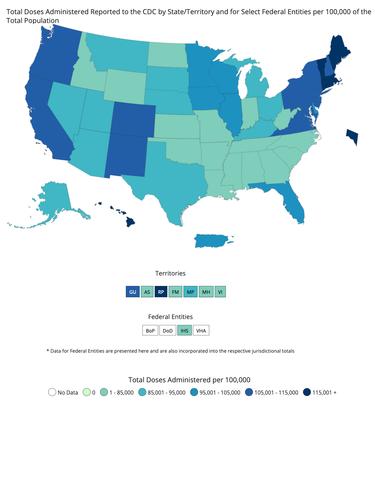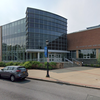Week LXVII: Cuomo lifts disaster emergency, state provides $25M in child care for essential workers
ALBANY COUNTY — New York’s state disaster emergency will be lifted on Thursday, June 24, Governor Andrew Cuomo announced on Wednesday.
The emergency was declared on March 7, 2020 to fight COVID-19 and had come under fire in recent months, particularly from Republicans, as an abuse of power by the governor.
The announcement ended a week, statewide and in Albany County, in which infection rates and hospitalizations remained low and vaccination rates inched upward. The week before, Cuomo announced the statewide lifting of most COVID-19 restrictions.
Federal guidance from the Centers for Disease Control and Prevention will remain in effect, which includes masks for unvaccinated people, as well as all riders on public transit and in certain settings, such as health care, nursing homes, correctional facilities, and homeless shelters. State and local government health departments will still be able to ensure mask rules and other health precautions are adhered to in those settings.
Senate Republican Leader Robert Ortt said the lifting was “long overdue” and said in a statement, “Now it is time for us to turn our undivided attention to the economic recovery and the rising crime wave devastating major metro areas all across the state. As elected officials, we must lead by example. Government officials should finally resume normal operations including making themselves available to the public and press.”
At an event in New York City on Wednesday, Cuomo unveiled plans for a monument to essential workers to be completed by Sept. 6 in Battery Park City. The Circle of Heroes will feature 19 red maple trees and an eternal flame.
Cuomo also announced that the state will provide $25 million in child-care scholarships to all essential workers starting June 23. Essential workers include first responders such as health-care providers, pharmaceutical staff, law enforcement, firefighters, transportation workers, food-delivery workers, grocery-store employees, and others.
This is the first in a series of new investments to support working families and the child-care industry through the federal Coronavirus Response and Relief Supplemental Appropriations Act and American Rescue Plan Act.
Child-care costs will be covered for essential staff whose income is less than 300 percent of the federal poverty level (or $79,500 for a family of four) and will be paid up to market rate for each region statewide for children aged six weeks through 12 years. Families currently receiving child-care scholarships under the Coronavirus Aid, Relief and Economic Security Act are encouraged to also apply for this new funding. CARES child-care scholarships will end on June 28; those currently receiving CARES scholarships will need to reapply.
Parents will apply for funding through a single online application, and providers will be paid directly on behalf of the parent. Applications will be processed and awarded on a first-come, first-served basis.
Essential workers can use the funding to pay for their existing care arrangement, or for a new child-care provider. Workers who need child care can contact their local child-care resource and referral agency to find openings. The New York State Office of Children and Family Services will administer the funding.
Vax rates
Three-quarters of Albany County adults had received at least one dose of COVID-19 vaccine, the county executive, Daniel McCoy, announced on Monday morning. By Wednesday, that had increased to 75.1 percent.
As of Wednesday evening, the Centers for Disease Control and Prevention reported that 65.6 percent of Americans 18 and older had received at least one dose. A CDC map shows the least vaccinated states are largely in the south, save Florida, and in the Southwest while the most heavily vaccinated states are in New England, on the West Coast, and in Hawaii.
The CDC has also parsed out vaccination rates by age, stating in a report released on Monday, “If the current rate of vaccination continues through August, coverage among young adults will remain substantially lower than among older adults …. Efforts to improve vaccination coverage are needed, especially among younger adults, to reduce COVID-19 cases, hospitalizations, and deaths.”
By May 22, the report says, 57.0 percent of United States adults had received at least one vaccine dose; coverage was highest — at 80 percent — among adults aged 65 years older, and lowest among adults aged 18 to 29 years, at 38.3 percent.
Men had lower coverage than women in all age groups, except those aged 65 and older. Residents of counties that are less urban were less likely to be vaccinated, the report said.
“Across all age groups, people living in counties with higher social vulnerabilities or higher percentages of the population who are uninsured, living in poverty, lacking access to a computer, and lacking access to a computer with Internet were less likely to be vaccinated,” the report said.
While statewide, New York last week reached the 70-percent mark of adults with at least one dose of vaccine, lifting restrictions, vaccination rates vary across the state.
On Friday, the state’s vaccine tracker started listing the rates according to ZIP code.
In Albany County, the lowest rate of residents who have received one dose is 1222 in Albany at 7.7 percent and the highest is 12007 in Alcove at 100 percent.
These are the rates for Thursday, from lowest to highest, in The Enterprise coverage area with the first number being the percentage who have gotten a least one dose and the second number representing the percentage who have been fully vaccinated for each ZIP code:
— 12046, Coeymans Hollow, 29.1 percent, 26.7 percent;
— 12120, Medusa: 41.3 percent, 36.9 percent;
— 12161, South Bethlehem: 41.4 percent, 39.3 percent;
— 12023, Berne: 47.1 percent, 44.2 percent;
— 12469, Preston Hollow: 47.9 percent, 43.2 percent;
— 12041, Clarksville:49.6 percent, 48.7 percent;
— 12193, Westerlo: 52.9 percent, 49.0 percent
— 12059, East Berne: 54.5 percent, 51.6 percent;
— 12067, Feura Bush: 54.9 percent, 51.7 percent
— 12203, Albany: 58.4 percent, 54.5 percent;
— 12147, Rensselaerville, 62.4 percent, 61.6 percent;
— 12009, Altamont: 64.0 percent, 60.2 percent;
— 12084, Guilderland: 67.1 percent, 61.5 percent
— 12085, Guilderland Center:74.5 percent, 67.9 percent;
— 12186, Voorheesville: 75.7 percent, 71.9 percent;
— 12054, Delmar: 80.5 percent, 75.5 percent; and
— 12159, Slingerlands: 83.3 percent, 78.6 percent.
Statewide, as of Wednesday evening, the vaccination rate for New Yorkers 18 and older who have gotten one dose is 71.2 percent while 52.3 percent of New Yorkers have completed a vaccination series.
According to the state’s vaccine tracker, 64.4 percent of Albany County’s 307,117 residents have received at least one dose while 75.1 percent of those 18 and older have.
This week, the CDC warned that the Delta variant of COVID-19 — which is now dominant in India, where it was first identified in October, and in Russia and the United Kingdom — is now responsible for about a 10th of the cases in the United States.
The vaccines currently authorized in the United States — made by Pfizer-BioNTech, Moderna, and Johnson & Johnson — have so far been effective against variant strains but the concern is that a mutation of the Delta variant could evade the vaccine.
Despite increased vaccination rates and decreased infection rates, the disease is still deadly. McCoy reported a June 18 death, of a woman in her fifties, bringing Albany County’s COVID-19 death toll to 386.
Financial news
State tax receipts through the first two months of State Fiscal Year 2021-22 were $4 billion higher than forecast in the Enacted Budget Financial Plan, according to the monthly State Cash Report released by New York State Comptroller Thomas DiNapoli.
Local sales tax collections, which had dipped precipitously a year ago as the result of restrictions to contain the pandemic, in May increased by 57.8 percent over last May, the highest one-month increase in recent history, DiNapoli announced. Collections totaled $1.4 billion, up $530 million from May of last year.
Statewide, local sales-tax collections surged nearly 58 percent in May, according to an analysis from the Comptroller’s Office. The rate is 6.9 percent more — which is $93 million more — than May 2019, before the pandemic.
Albany County, the report says, collected $15.4 million in local sales tax in May 2020 and $23.0 million in May 2021 — an increase of 48.8 percent.
The Capital Region overall saw a 59.5 percent increase, going from $40.5 million last May to $64.7 million this May in local sales tax.
“The state is emerging from the pandemic on solid fiscal footing because of robust tax revenue growth and an unprecedented infusion of federal assistance,” said DiNapoli in releasing the report. “Still, economic uncertainties remain and caution is warranted going forward.”
On Wednesday, the state’s labor department released preliminary unemployment rates for May that showed, statewide, the unemployment rate decreased from 8.2 percent in April to 7.8 percent in May.
For the Albany-Schenectady-Troy area, the rate dropped significantly from May 2020, when it was 10.5 percent, to May of this year, at 4.3 percent.
The Empire Center, a nonpartisan, not-for-profit think tank based in Albany, reported this week that the post-pandemic income bounce in New York was lower than in most states.
“Last week, the state Labor Department released data showing the state’s recovery of private-sector payroll jobs as of May was also far behind the national average, increasing at a pace that won’t produce a full jobs recovery (to February 2020 level) until 2025,” wrote Edmund J. McMahon, Empire Center’s founder and a senior fellow.
He largely focused on personal income, writing, “On an annualized basis (i.e., the rate of change that would have occurred had the pattern been repeated over four quarters), personal income in New York from January through March was up 51.9 percent from the ultra-low level reflecting the state’s broad economic and social shutdown starting a year earlier, the BEA estimated,” McMahon wrote, referencing the Bureau of Economic Analysis. “By comparison, the 50-state change in personal income in the first quarter was 59.7 percent.
“In both cases, nearly all of the income gain (91 percent in New York; 93 percent nationally) was categorized as transfer receipts to individuals, reflecting ‘new government pandemic relief payments provided by the [federal] Coronavirus Response and Relief Supplemental Appropriations (CRRSA) Act and the American Rescue Plan Act,’ the BEA noted. The rest of the increase would have flowed through personal earnings from employment, dividends, interest and rent.”
Newest numbers
On Wednesday morning, in a release, McCoy announced four new cases of COVID-19, bringing Albany County’s tally to 24,408.
Albany County’s most recent seven-day average of percent positive rates is still 0.4 percent. There are now 19 active cases in the county, down from 20 on Tuesday.
The number of Albany County residents under quarantine increased to 73 from 68. So far, 80,004 residents have completed quarantine. Of those, 24,389 had tested positive and recovered, an increase of five recoveries.
There were no new hospitalizations overnight, and three county residents remain hospitalized from the virus. There is now one patient in an intensive-care unit, up from zero yesterday.
Albany County’s COVID-19 death toll remains at 386.



